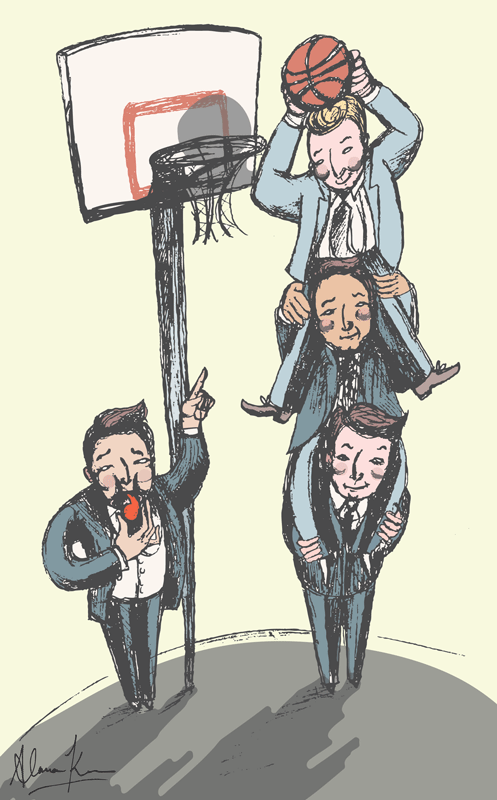By Paolo Guenzi & Dino Ruta
Sport can use some managerial know-how, and managers have a lot to learn from the world of sport. Below, Paolo Guenzi and Dino Ruta offer a scheme to link sport characteristics and business variables, discovering how team management models typically used in traditional businesses can be found in or transferred to sports teams, and vice versa.
Integrating sport and management perspectives
Why another book on Team Leadership? Because managers have a lot to learn from the world of sport. Most books on this topic are based on the experience of individual coaches or offer a compendium of experiences and quotes from various coaches, but they make no reference to the immense store of knowledge on leadership, team leadership, coaching and management in general. Why waste this priceless inheritance? Our challenge was to merge the empirical/anecdotal viewpoint that springs from the experiences in the field by leaders in team sports with a more ‘scientific’ perspective based on research carried out in academic and managerial contexts. First of all, we systematically compare and contrast the worlds of sport and business, to avert any inappropriate comparisons and highlight the conditions that enable managers to make useful ones instead. The sports context is often used as a powerful analogy for analysing and interpreting teamwork, motivation, and leadership, with professional sports coaches held up as role models for managers. But it’s not always advisable to take principles, models, and best practices from the world of sports and apply them to business. Any comparison with the world of sports, if applied inappropriately, can lead to mistakes and end up being ineffective or even counterproductive. Transposing concepts and managerial models from professional sports teams to business teams can and should be done, but only to the extent to which the teams in both contexts are alike, sharing similar goals and tasks, and having similar structures and methods of operation. Successful leadership models in sports can be used in business contexts, keeping in mind that the greater the similarity between the specific sports and business teams the more expedient this transposition will be. We argue that managers who look to sports for useful tips to apply to their business should think carefully about which particular sport would best serve as their model. We identify six typical models of sports characterised by different levels and forms of interdependence and suggest the types of corporate settings that are most similar to them. We also explain how the degree and type of interdependence among team members affect team processes and ultimately team leadership. In fact, team performance is determined by team processes, which are shaped largely by the team leader’s characteristics, competencies, and behaviours. Then we give an overview of current thinking on leadership in general and team leadership in particular, to build a solid methodological foundation that can serve as a framework for interpreting our interviews with the coaches.
[ms-protect-content id=”9932″]A relational approach to team leadership
Based on an in-depth review of team leadership, we identify four fundamental categories of team processes (cognitive, motivational, affective, and coordination processes) and point out that team leadership functioning centers on four key pillars: the relationship between the leader and the team as a whole, relationships among team members, interdependence and reciprocal social support among team members, and the organisational structure needed to generate resources and information that serve to make decisions. We then propose an original model that places particular emphasis on the team leader’s ability to create his/her personal credibility with multiple stakeholders at different levels, from micro (typically the players on the team and the technical staff) to macro (other members of the organisation and external actors). This refers specifically to:
• individual team members (athletes)
• the team as a whole (including technical staff)
• the organisation as a whole (including non-athletes who work for the sports club)
• all relevant actors outside the club (media, fans, etc.)We highlight that these four levels of action are interdependent. For example, a coach who is a successful team leader on an individual and group level is usually also credible in the eyes of the club’s other stakeholders. By the same token, the legitimacy derived from these stakeholders typically gives the coach more credibility with the team as a whole and with individual team members. Team leaders therefore need to motivate individual athletes, build team spirit, synchronise organisational resources, and construct a positive reputation within their sphere. Their ability to achieve all this depends on what they do (their behaviours) and how they do it. We break down these behaviours into two macro-classes – managerial behaviours and coaching behaviours. In particular, our model contributes to the team leadership literature highlighting the relevance of team leaders behaviours’ impacts and as a consequence its focus on multiple relationships, rather than other elements such as: leaders’ attributes, team leaders’ behaviours and functions, one-directional relations between the leader and the follower.
Credibility for team performance
In our research, we find that this credibility derives from several attributes. Every coach has a personal notion of what it means to be credible and how to act, in concrete terms, to be seen as credible. Yet despite these subjective interpretations of the concept of credibility, certain components emerged time and time again.
Credibility derives from several perceptions that followers develop toward the team leader. The most frequently cited perceptions are:
• technical competency, which is normally seen as essential, but not sufficient, to be considered credible;
• energy, often associated with the outcome of both enthusiasm and passion;
• fairness, which can be seen as a combination of sincerity, spontaneity, and good ethics;
• consistency of actions and underlying principles across time and situations.In general, we found that credibility is the outcome of countless actions. It is the result of the combination of what team leaders do (i.e. their behaviours) and how they do it (their attitudes); in other words, how they work and interact with several key actors, not only the team members (players and staff, in our case). As for the ‘what’, our research has identified two macro areas of conceptually separate yet interdependent behaviours: managerial and coaching behaviours. The latter are targeted to team members, whereas the former mainly address other actors, both inside and outside the sports organisation. To determine the effectiveness of these behaviours and how they are put into practice, we have to consider a number of circumstances. In other words, whether or not these behaviours are appropriate depends on how consistent they are with specific situational variables. We identify a number of relevant situational variables: structural, functional and results characteristics at the individual, team, organisation and environment levels. The ability to evaluate, comprehend, and deal with specific situations, adapting managerial or coaching behaviours accordingly, is an additional competency that team leaders have to hone to reinforce their credibility at various levels: the individual, the team, the organisation and the environment.
Leadership and motivation
Finally, in our book, using applicable excerpts from interviews with 80 coaches from a variety of sports (football, basketball, volleyball, rugby, and tennis), we identify the key functions and strategic behaviours of team leaders as managers and coaches, with special focus on the processes that team leaders implement to promote team motivation. The team leader as manager deals with technique and mission, tactics and market, and at the same time vouches for the quality of the project, answering to players, fans, owners, media and key stakeholders. Team leaders as managers acquire new competencies to manage a more complex organisation, in light of the higher level of technical abilities of the players; greater expectations of athletes, fans, and owners; more intense environmental pressure; more numerous key stakeholders – often with conflicting interests – who affect the club’s decisions.
The team leader as Manager and as Coach
Team leaders as managers also take on new roles: goal setting, planning and executing the season, negotiating resources with owners, organising staff activities, recruiting athletes and enabling them to fully realise their potential, handling relations with external stakeholders, in particular the media and the fans. They also delegate constructive activities and technical projects to competent, specialised staff members, dedicating time to coor¬dinate and manage these people so they can perform effectively and provide high quality services.
As for the team leaders as coach, instead, we explain the interdependence between motivational, consultative and educational coaching in teams, and propose a specific motivational toolkit for team leaders, based on non-monetary forms of rewards adopted by successful sport coaches. We offer dozens of salient citations and ‘food for thought’ from sport coaches, which we systematically organise in logical categories and classes of behaviours that have the power to impact team performance. Finally we summarise the key passages from conversations with thirteen professional coaches; each of them has an exceptional and unique personal story, replete with insight and inspiration. The entire book is interspersed with examples and anecdotes that enrich the content and provide a powerful inheritance of real life experience which provides readers with pertinent, practical ideas, and incentives for proactively developing a more organised, responsible, meritocratic and collaborative way to work together as a team.
Download the digital edition of The European Business Review from Zinio.
About the Authors
Paolo Guenzi is Associate Professor in the Department of Marketing at Bocconi University, and Professor in the Department of Marketing at SDA Bocconi School of Management, where he is the director of the courses on sales management. He has published several books and more than thirty articles in leading academic journals. He is in the Editorial Board of the Journal of Personal Selling & Sales Management, and the International Journal of Sport Marketing & Sponsorship.
Dino Ruta is Professor of Leadership and Sport management at SDA Bocconi School of Management. He is Scientific Director of the FIFA International Master in Humanities, Management and Law of Sports. He leads the Sport Business Academy and the Sport Knowledge Center at SDA Bocconi School of Management. He has published in leading academic journals as well as publishing books for several international publishers.





























![“Does Everyone Hear Me OK?”: How to Lead Virtual Teams Effectively iStock-1438575049 (1) [Converted]](https://www.europeanbusinessreview.com/wp-content/uploads/2024/11/iStock-1438575049-1-Converted-100x70.jpg)




